Vicarious Liability of Employer for Employee's Actions
VerifiedAdded on 2019/12/03
|10
|3181
|249
Report
AI Summary
An employer can be considered vicarious liable for the actions of an employee if they had assigned a task to the employee who lacked knowledge about it. This is because the employer has control over the employee and their actions. The Control test is applied to assess the relationship between the worker and the person or firm, which establishes the employer's liability for the employee's actions.
Contribute Materials
Your contribution can guide someone’s learning journey. Share your
documents today.
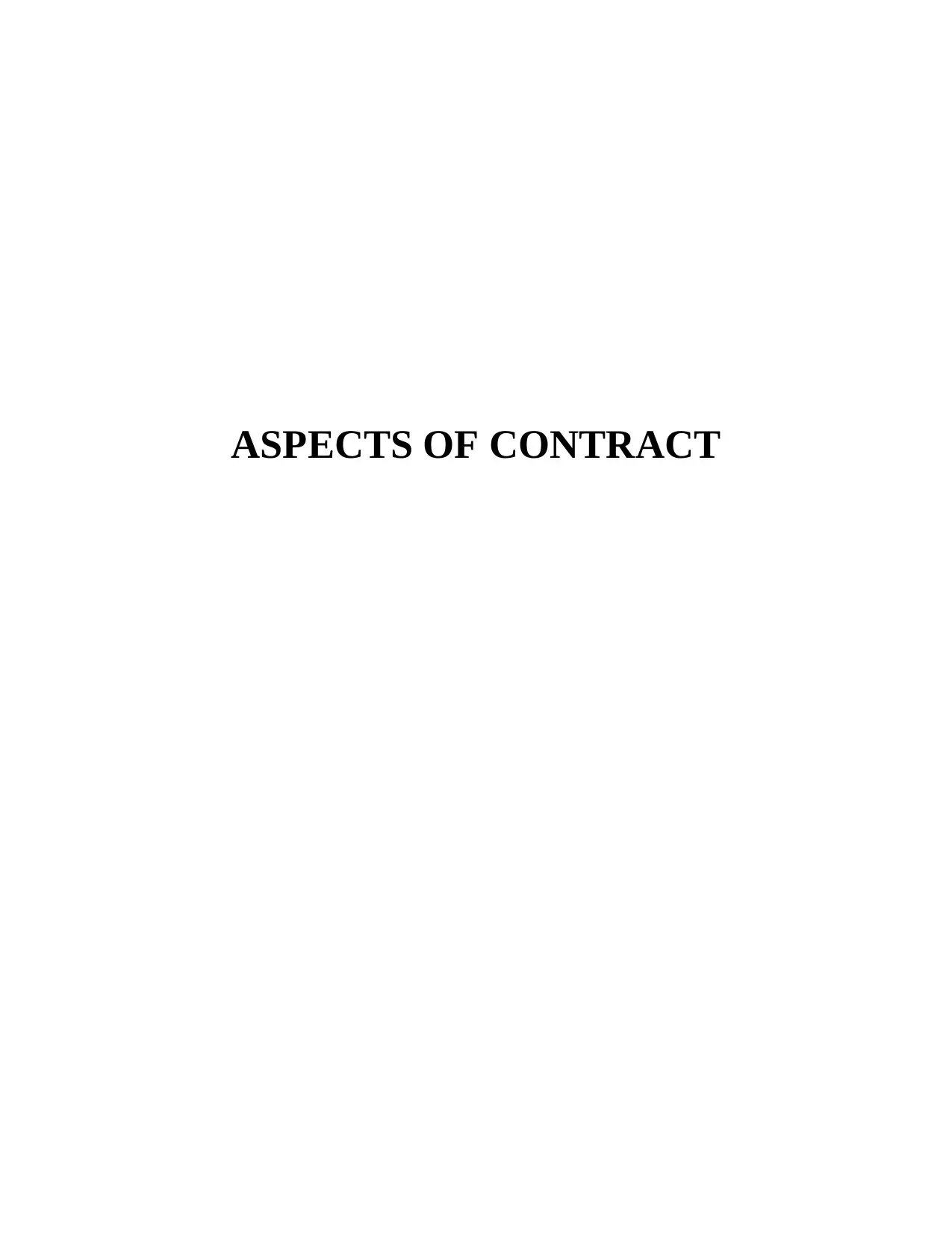
ASPECTS OF CONTRACT
Secure Best Marks with AI Grader
Need help grading? Try our AI Grader for instant feedback on your assignments.
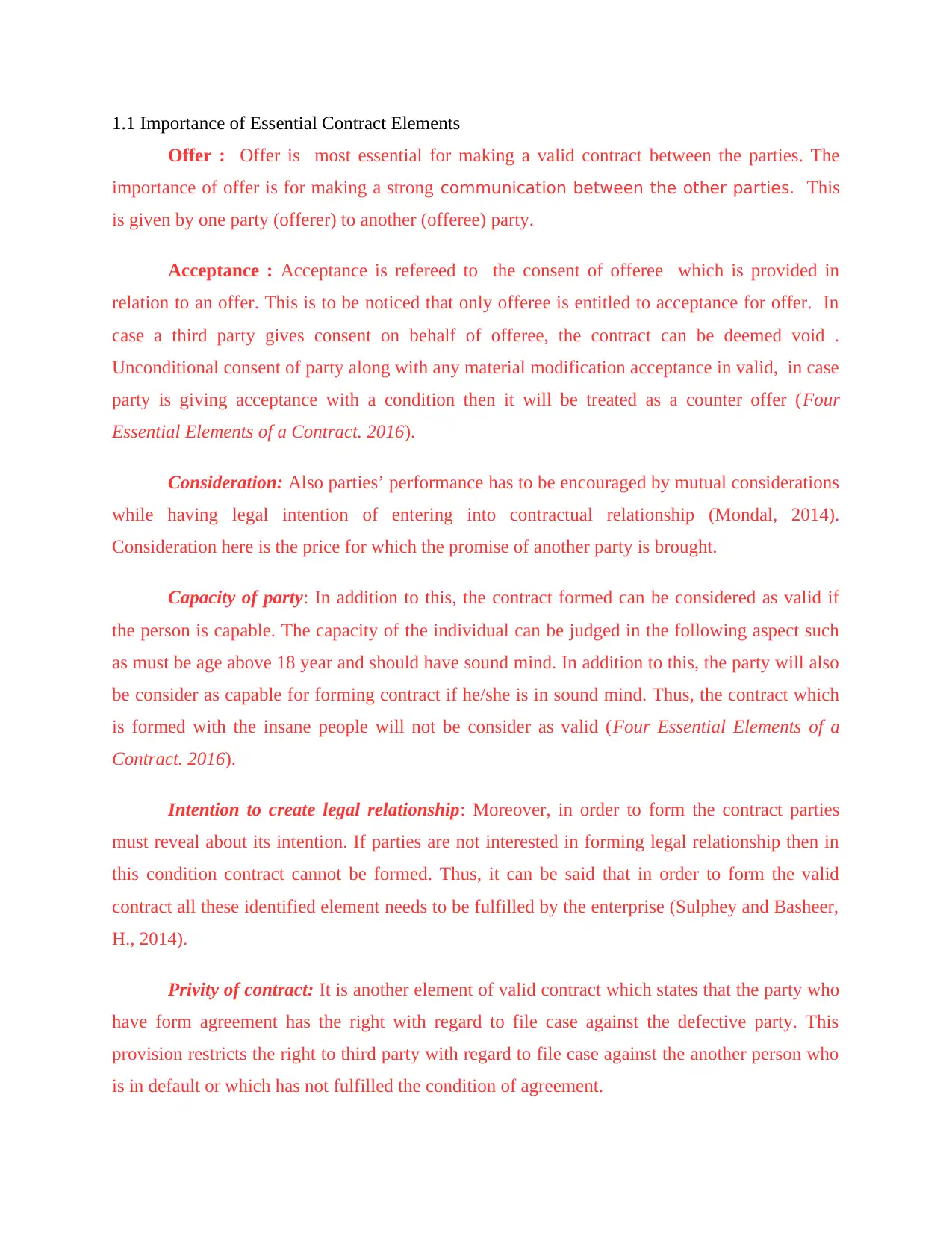
1.1 Importance of Essential Contract Elements
Offer : Offer is most essential for making a valid contract between the parties. The
importance of offer is for making a strong communication between the other parties. This
is given by one party (offerer) to another (offeree) party.
Acceptance : Acceptance is refereed to the consent of offeree which is provided in
relation to an offer. This is to be noticed that only offeree is entitled to acceptance for offer. In
case a third party gives consent on behalf of offeree, the contract can be deemed void .
Unconditional consent of party along with any material modification acceptance in valid, in case
party is giving acceptance with a condition then it will be treated as a counter offer (Four
Essential Elements of a Contract. 2016).
Consideration: Also parties’ performance has to be encouraged by mutual considerations
while having legal intention of entering into contractual relationship (Mondal, 2014).
Consideration here is the price for which the promise of another party is brought.
Capacity of party: In addition to this, the contract formed can be considered as valid if
the person is capable. The capacity of the individual can be judged in the following aspect such
as must be age above 18 year and should have sound mind. In addition to this, the party will also
be consider as capable for forming contract if he/she is in sound mind. Thus, the contract which
is formed with the insane people will not be consider as valid (Four Essential Elements of a
Contract. 2016).
Intention to create legal relationship: Moreover, in order to form the contract parties
must reveal about its intention. If parties are not interested in forming legal relationship then in
this condition contract cannot be formed. Thus, it can be said that in order to form the valid
contract all these identified element needs to be fulfilled by the enterprise (Sulphey and Basheer,
H., 2014).
Privity of contract: It is another element of valid contract which states that the party who
have form agreement has the right with regard to file case against the defective party. This
provision restricts the right to third party with regard to file case against the another person who
is in default or which has not fulfilled the condition of agreement.
Offer : Offer is most essential for making a valid contract between the parties. The
importance of offer is for making a strong communication between the other parties. This
is given by one party (offerer) to another (offeree) party.
Acceptance : Acceptance is refereed to the consent of offeree which is provided in
relation to an offer. This is to be noticed that only offeree is entitled to acceptance for offer. In
case a third party gives consent on behalf of offeree, the contract can be deemed void .
Unconditional consent of party along with any material modification acceptance in valid, in case
party is giving acceptance with a condition then it will be treated as a counter offer (Four
Essential Elements of a Contract. 2016).
Consideration: Also parties’ performance has to be encouraged by mutual considerations
while having legal intention of entering into contractual relationship (Mondal, 2014).
Consideration here is the price for which the promise of another party is brought.
Capacity of party: In addition to this, the contract formed can be considered as valid if
the person is capable. The capacity of the individual can be judged in the following aspect such
as must be age above 18 year and should have sound mind. In addition to this, the party will also
be consider as capable for forming contract if he/she is in sound mind. Thus, the contract which
is formed with the insane people will not be consider as valid (Four Essential Elements of a
Contract. 2016).
Intention to create legal relationship: Moreover, in order to form the contract parties
must reveal about its intention. If parties are not interested in forming legal relationship then in
this condition contract cannot be formed. Thus, it can be said that in order to form the valid
contract all these identified element needs to be fulfilled by the enterprise (Sulphey and Basheer,
H., 2014).
Privity of contract: It is another element of valid contract which states that the party who
have form agreement has the right with regard to file case against the defective party. This
provision restricts the right to third party with regard to file case against the another person who
is in default or which has not fulfilled the condition of agreement.
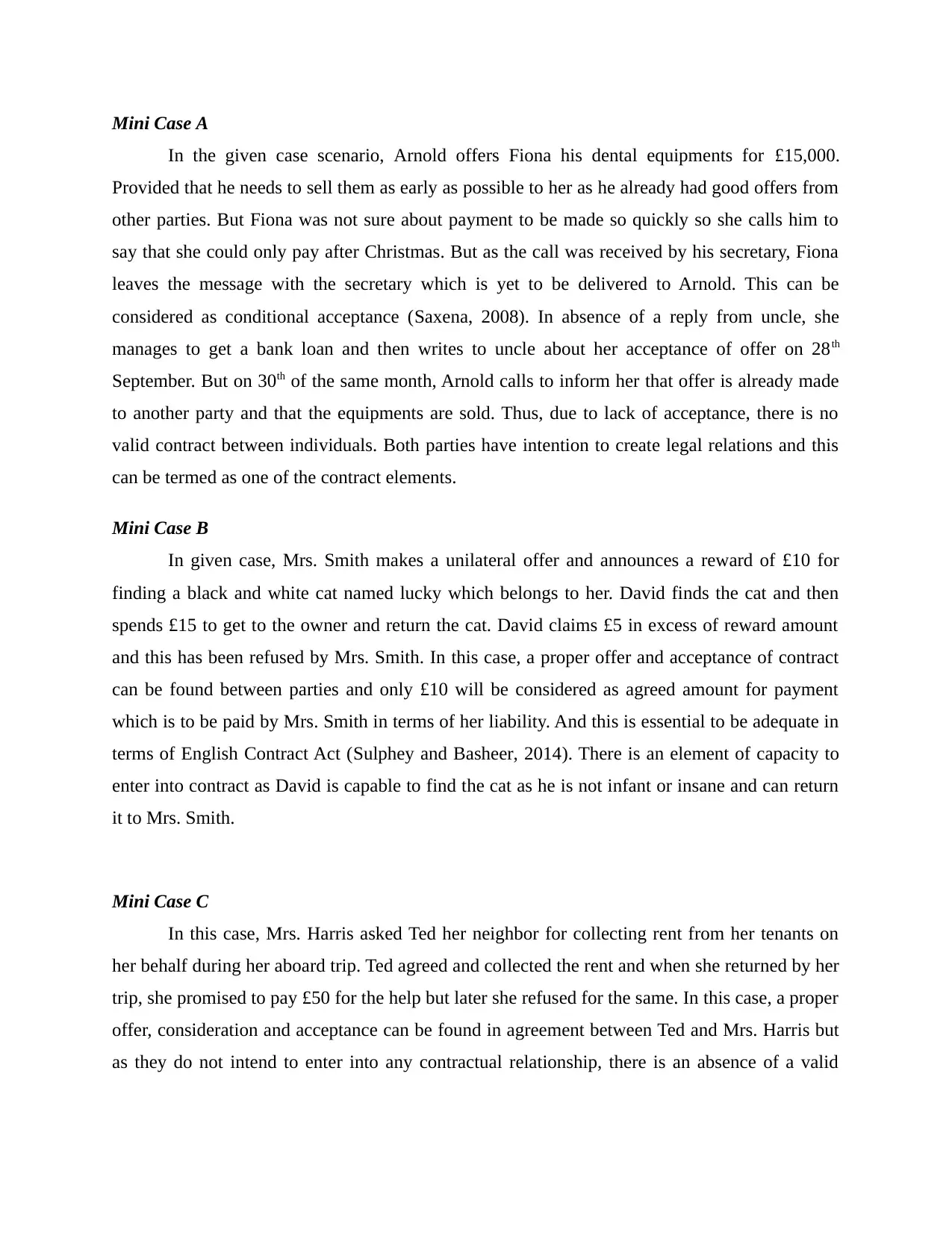
Mini Case A
In the given case scenario, Arnold offers Fiona his dental equipments for £15,000.
Provided that he needs to sell them as early as possible to her as he already had good offers from
other parties. But Fiona was not sure about payment to be made so quickly so she calls him to
say that she could only pay after Christmas. But as the call was received by his secretary, Fiona
leaves the message with the secretary which is yet to be delivered to Arnold. This can be
considered as conditional acceptance (Saxena, 2008). In absence of a reply from uncle, she
manages to get a bank loan and then writes to uncle about her acceptance of offer on 28th
September. But on 30th of the same month, Arnold calls to inform her that offer is already made
to another party and that the equipments are sold. Thus, due to lack of acceptance, there is no
valid contract between individuals. Both parties have intention to create legal relations and this
can be termed as one of the contract elements.
Mini Case B
In given case, Mrs. Smith makes a unilateral offer and announces a reward of £10 for
finding a black and white cat named lucky which belongs to her. David finds the cat and then
spends £15 to get to the owner and return the cat. David claims £5 in excess of reward amount
and this has been refused by Mrs. Smith. In this case, a proper offer and acceptance of contract
can be found between parties and only £10 will be considered as agreed amount for payment
which is to be paid by Mrs. Smith in terms of her liability. And this is essential to be adequate in
terms of English Contract Act (Sulphey and Basheer, 2014). There is an element of capacity to
enter into contract as David is capable to find the cat as he is not infant or insane and can return
it to Mrs. Smith.
Mini Case C
In this case, Mrs. Harris asked Ted her neighbor for collecting rent from her tenants on
her behalf during her aboard trip. Ted agreed and collected the rent and when she returned by her
trip, she promised to pay £50 for the help but later she refused for the same. In this case, a proper
offer, consideration and acceptance can be found in agreement between Ted and Mrs. Harris but
as they do not intend to enter into any contractual relationship, there is an absence of a valid
In the given case scenario, Arnold offers Fiona his dental equipments for £15,000.
Provided that he needs to sell them as early as possible to her as he already had good offers from
other parties. But Fiona was not sure about payment to be made so quickly so she calls him to
say that she could only pay after Christmas. But as the call was received by his secretary, Fiona
leaves the message with the secretary which is yet to be delivered to Arnold. This can be
considered as conditional acceptance (Saxena, 2008). In absence of a reply from uncle, she
manages to get a bank loan and then writes to uncle about her acceptance of offer on 28th
September. But on 30th of the same month, Arnold calls to inform her that offer is already made
to another party and that the equipments are sold. Thus, due to lack of acceptance, there is no
valid contract between individuals. Both parties have intention to create legal relations and this
can be termed as one of the contract elements.
Mini Case B
In given case, Mrs. Smith makes a unilateral offer and announces a reward of £10 for
finding a black and white cat named lucky which belongs to her. David finds the cat and then
spends £15 to get to the owner and return the cat. David claims £5 in excess of reward amount
and this has been refused by Mrs. Smith. In this case, a proper offer and acceptance of contract
can be found between parties and only £10 will be considered as agreed amount for payment
which is to be paid by Mrs. Smith in terms of her liability. And this is essential to be adequate in
terms of English Contract Act (Sulphey and Basheer, 2014). There is an element of capacity to
enter into contract as David is capable to find the cat as he is not infant or insane and can return
it to Mrs. Smith.
Mini Case C
In this case, Mrs. Harris asked Ted her neighbor for collecting rent from her tenants on
her behalf during her aboard trip. Ted agreed and collected the rent and when she returned by her
trip, she promised to pay £50 for the help but later she refused for the same. In this case, a proper
offer, consideration and acceptance can be found in agreement between Ted and Mrs. Harris but
as they do not intend to enter into any contractual relationship, there is an absence of a valid
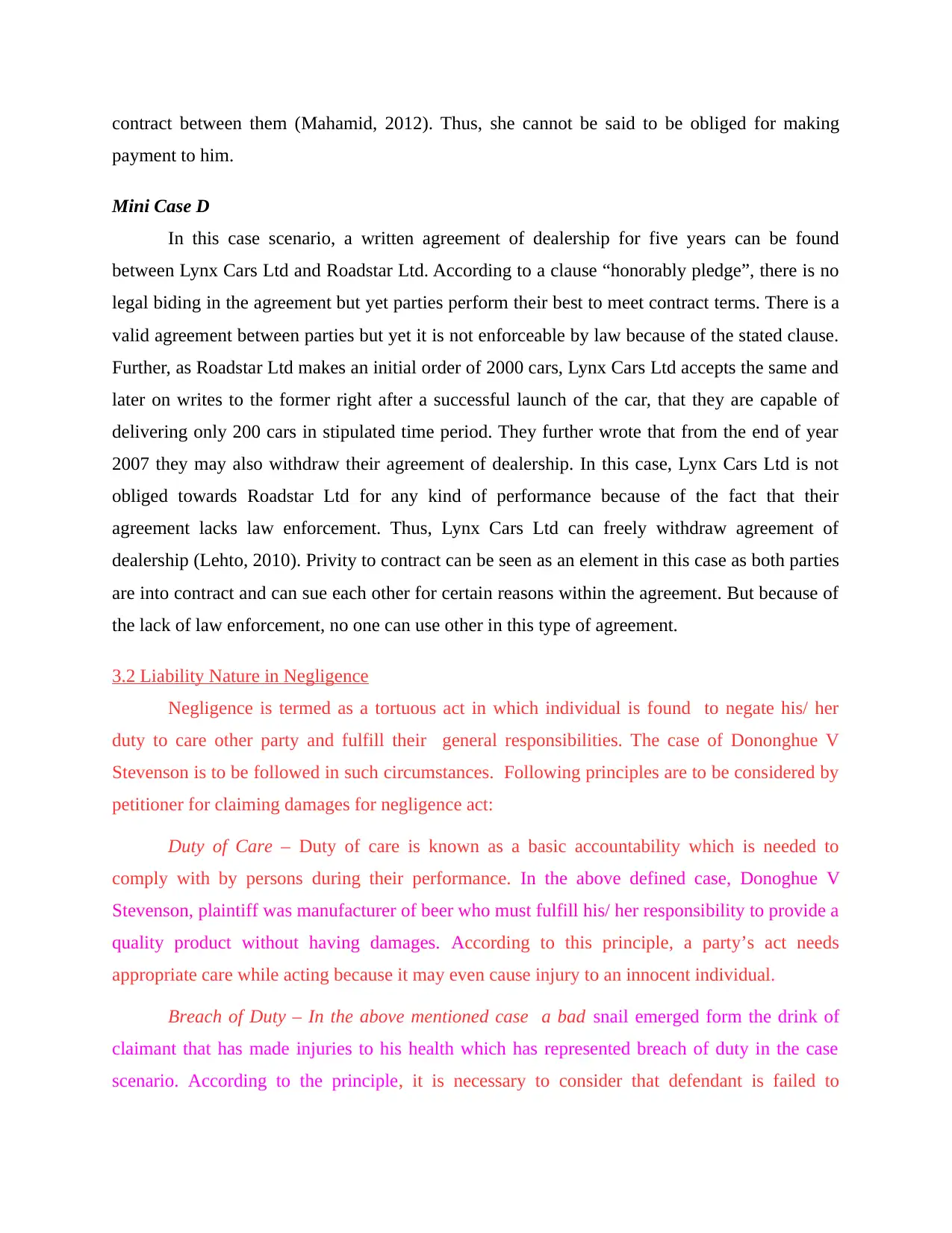
contract between them (Mahamid, 2012). Thus, she cannot be said to be obliged for making
payment to him.
Mini Case D
In this case scenario, a written agreement of dealership for five years can be found
between Lynx Cars Ltd and Roadstar Ltd. According to a clause “honorably pledge”, there is no
legal biding in the agreement but yet parties perform their best to meet contract terms. There is a
valid agreement between parties but yet it is not enforceable by law because of the stated clause.
Further, as Roadstar Ltd makes an initial order of 2000 cars, Lynx Cars Ltd accepts the same and
later on writes to the former right after a successful launch of the car, that they are capable of
delivering only 200 cars in stipulated time period. They further wrote that from the end of year
2007 they may also withdraw their agreement of dealership. In this case, Lynx Cars Ltd is not
obliged towards Roadstar Ltd for any kind of performance because of the fact that their
agreement lacks law enforcement. Thus, Lynx Cars Ltd can freely withdraw agreement of
dealership (Lehto, 2010). Privity to contract can be seen as an element in this case as both parties
are into contract and can sue each other for certain reasons within the agreement. But because of
the lack of law enforcement, no one can use other in this type of agreement.
3.2 Liability Nature in Negligence
Negligence is termed as a tortuous act in which individual is found to negate his/ her
duty to care other party and fulfill their general responsibilities. The case of Dononghue V
Stevenson is to be followed in such circumstances. Following principles are to be considered by
petitioner for claiming damages for negligence act:
Duty of Care – Duty of care is known as a basic accountability which is needed to
comply with by persons during their performance. In the above defined case, Donoghue V
Stevenson, plaintiff was manufacturer of beer who must fulfill his/ her responsibility to provide a
quality product without having damages. According to this principle, a party’s act needs
appropriate care while acting because it may even cause injury to an innocent individual.
Breach of Duty – In the above mentioned case a bad snail emerged form the drink of
claimant that has made injuries to his health which has represented breach of duty in the case
scenario. According to the principle, it is necessary to consider that defendant is failed to
payment to him.
Mini Case D
In this case scenario, a written agreement of dealership for five years can be found
between Lynx Cars Ltd and Roadstar Ltd. According to a clause “honorably pledge”, there is no
legal biding in the agreement but yet parties perform their best to meet contract terms. There is a
valid agreement between parties but yet it is not enforceable by law because of the stated clause.
Further, as Roadstar Ltd makes an initial order of 2000 cars, Lynx Cars Ltd accepts the same and
later on writes to the former right after a successful launch of the car, that they are capable of
delivering only 200 cars in stipulated time period. They further wrote that from the end of year
2007 they may also withdraw their agreement of dealership. In this case, Lynx Cars Ltd is not
obliged towards Roadstar Ltd for any kind of performance because of the fact that their
agreement lacks law enforcement. Thus, Lynx Cars Ltd can freely withdraw agreement of
dealership (Lehto, 2010). Privity to contract can be seen as an element in this case as both parties
are into contract and can sue each other for certain reasons within the agreement. But because of
the lack of law enforcement, no one can use other in this type of agreement.
3.2 Liability Nature in Negligence
Negligence is termed as a tortuous act in which individual is found to negate his/ her
duty to care other party and fulfill their general responsibilities. The case of Dononghue V
Stevenson is to be followed in such circumstances. Following principles are to be considered by
petitioner for claiming damages for negligence act:
Duty of Care – Duty of care is known as a basic accountability which is needed to
comply with by persons during their performance. In the above defined case, Donoghue V
Stevenson, plaintiff was manufacturer of beer who must fulfill his/ her responsibility to provide a
quality product without having damages. According to this principle, a party’s act needs
appropriate care while acting because it may even cause injury to an innocent individual.
Breach of Duty – In the above mentioned case a bad snail emerged form the drink of
claimant that has made injuries to his health which has represented breach of duty in the case
scenario. According to the principle, it is necessary to consider that defendant is failed to
Secure Best Marks with AI Grader
Need help grading? Try our AI Grader for instant feedback on your assignments.
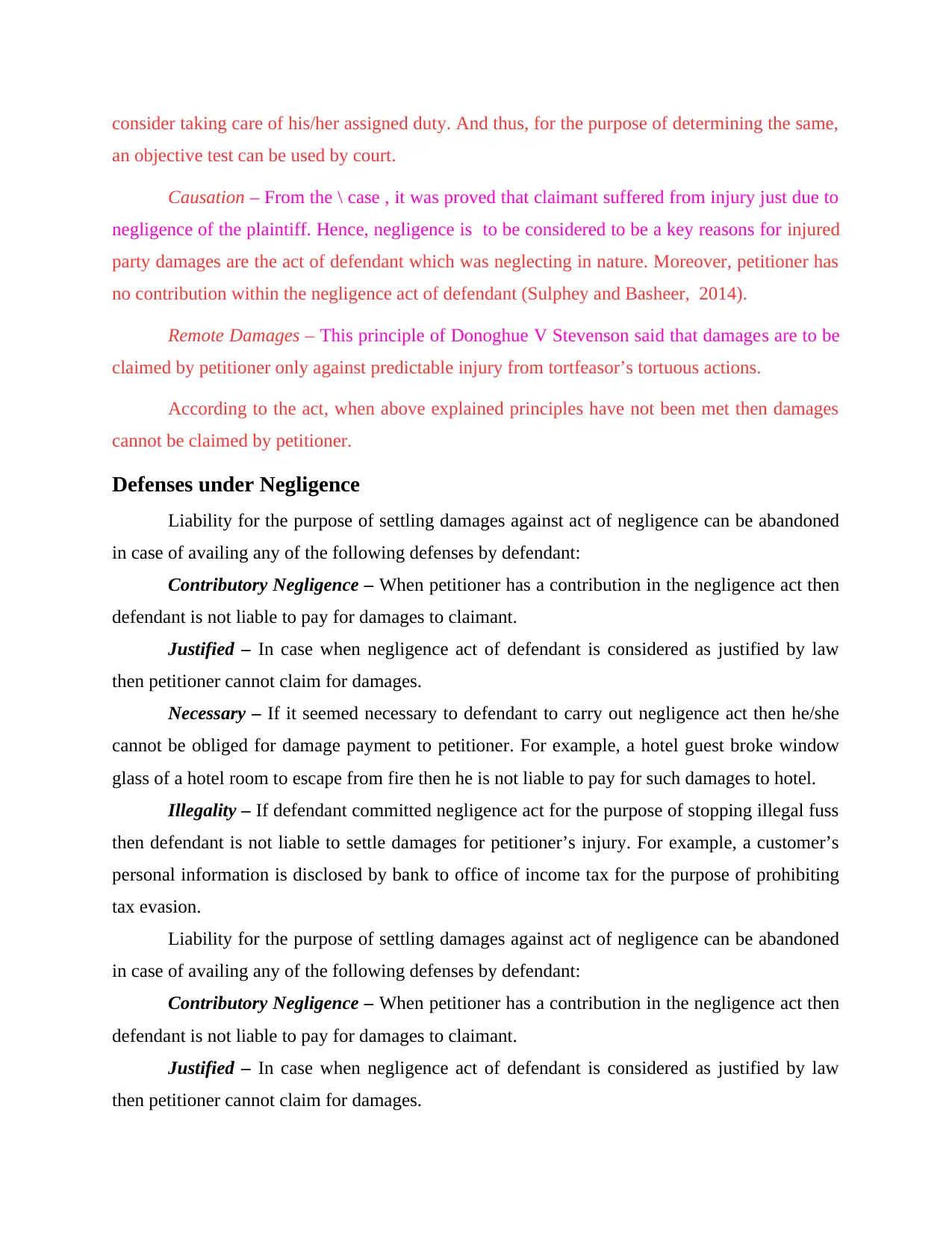
consider taking care of his/her assigned duty. And thus, for the purpose of determining the same,
an objective test can be used by court.
Causation – From the \ case , it was proved that claimant suffered from injury just due to
negligence of the plaintiff. Hence, negligence is to be considered to be a key reasons for injured
party damages are the act of defendant which was neglecting in nature. Moreover, petitioner has
no contribution within the negligence act of defendant (Sulphey and Basheer, 2014).
Remote Damages – This principle of Donoghue V Stevenson said that damages are to be
claimed by petitioner only against predictable injury from tortfeasor’s tortuous actions.
According to the act, when above explained principles have not been met then damages
cannot be claimed by petitioner.
Defenses under Negligence
Liability for the purpose of settling damages against act of negligence can be abandoned
in case of availing any of the following defenses by defendant:
Contributory Negligence – When petitioner has a contribution in the negligence act then
defendant is not liable to pay for damages to claimant.
Justified – In case when negligence act of defendant is considered as justified by law
then petitioner cannot claim for damages.
Necessary – If it seemed necessary to defendant to carry out negligence act then he/she
cannot be obliged for damage payment to petitioner. For example, a hotel guest broke window
glass of a hotel room to escape from fire then he is not liable to pay for such damages to hotel.
Illegality – If defendant committed negligence act for the purpose of stopping illegal fuss
then defendant is not liable to settle damages for petitioner’s injury. For example, a customer’s
personal information is disclosed by bank to office of income tax for the purpose of prohibiting
tax evasion.
Liability for the purpose of settling damages against act of negligence can be abandoned
in case of availing any of the following defenses by defendant:
Contributory Negligence – When petitioner has a contribution in the negligence act then
defendant is not liable to pay for damages to claimant.
Justified – In case when negligence act of defendant is considered as justified by law
then petitioner cannot claim for damages.
an objective test can be used by court.
Causation – From the \ case , it was proved that claimant suffered from injury just due to
negligence of the plaintiff. Hence, negligence is to be considered to be a key reasons for injured
party damages are the act of defendant which was neglecting in nature. Moreover, petitioner has
no contribution within the negligence act of defendant (Sulphey and Basheer, 2014).
Remote Damages – This principle of Donoghue V Stevenson said that damages are to be
claimed by petitioner only against predictable injury from tortfeasor’s tortuous actions.
According to the act, when above explained principles have not been met then damages
cannot be claimed by petitioner.
Defenses under Negligence
Liability for the purpose of settling damages against act of negligence can be abandoned
in case of availing any of the following defenses by defendant:
Contributory Negligence – When petitioner has a contribution in the negligence act then
defendant is not liable to pay for damages to claimant.
Justified – In case when negligence act of defendant is considered as justified by law
then petitioner cannot claim for damages.
Necessary – If it seemed necessary to defendant to carry out negligence act then he/she
cannot be obliged for damage payment to petitioner. For example, a hotel guest broke window
glass of a hotel room to escape from fire then he is not liable to pay for such damages to hotel.
Illegality – If defendant committed negligence act for the purpose of stopping illegal fuss
then defendant is not liable to settle damages for petitioner’s injury. For example, a customer’s
personal information is disclosed by bank to office of income tax for the purpose of prohibiting
tax evasion.
Liability for the purpose of settling damages against act of negligence can be abandoned
in case of availing any of the following defenses by defendant:
Contributory Negligence – When petitioner has a contribution in the negligence act then
defendant is not liable to pay for damages to claimant.
Justified – In case when negligence act of defendant is considered as justified by law
then petitioner cannot claim for damages.
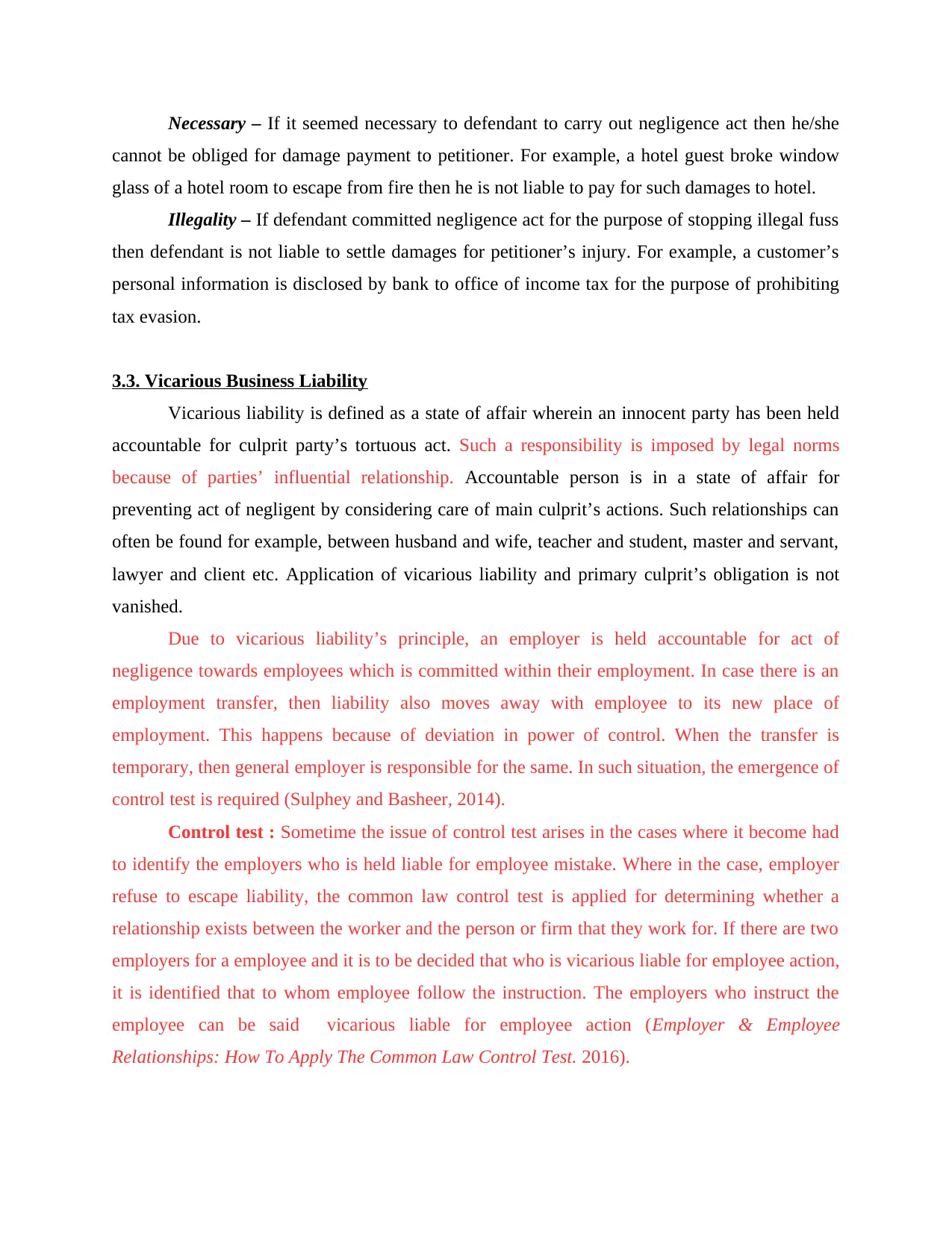
Necessary – If it seemed necessary to defendant to carry out negligence act then he/she
cannot be obliged for damage payment to petitioner. For example, a hotel guest broke window
glass of a hotel room to escape from fire then he is not liable to pay for such damages to hotel.
Illegality – If defendant committed negligence act for the purpose of stopping illegal fuss
then defendant is not liable to settle damages for petitioner’s injury. For example, a customer’s
personal information is disclosed by bank to office of income tax for the purpose of prohibiting
tax evasion.
3.3. Vicarious Business Liability
Vicarious liability is defined as a state of affair wherein an innocent party has been held
accountable for culprit party’s tortuous act. Such a responsibility is imposed by legal norms
because of parties’ influential relationship. Accountable person is in a state of affair for
preventing act of negligent by considering care of main culprit’s actions. Such relationships can
often be found for example, between husband and wife, teacher and student, master and servant,
lawyer and client etc. Application of vicarious liability and primary culprit’s obligation is not
vanished.
Due to vicarious liability’s principle, an employer is held accountable for act of
negligence towards employees which is committed within their employment. In case there is an
employment transfer, then liability also moves away with employee to its new place of
employment. This happens because of deviation in power of control. When the transfer is
temporary, then general employer is responsible for the same. In such situation, the emergence of
control test is required (Sulphey and Basheer, 2014).
Control test : Sometime the issue of control test arises in the cases where it become had
to identify the employers who is held liable for employee mistake. Where in the case, employer
refuse to escape liability, the common law control test is applied for determining whether a
relationship exists between the worker and the person or firm that they work for. If there are two
employers for a employee and it is to be decided that who is vicarious liable for employee action,
it is identified that to whom employee follow the instruction. The employers who instruct the
employee can be said vicarious liable for employee action (Employer & Employee
Relationships: How To Apply The Common Law Control Test. 2016).
cannot be obliged for damage payment to petitioner. For example, a hotel guest broke window
glass of a hotel room to escape from fire then he is not liable to pay for such damages to hotel.
Illegality – If defendant committed negligence act for the purpose of stopping illegal fuss
then defendant is not liable to settle damages for petitioner’s injury. For example, a customer’s
personal information is disclosed by bank to office of income tax for the purpose of prohibiting
tax evasion.
3.3. Vicarious Business Liability
Vicarious liability is defined as a state of affair wherein an innocent party has been held
accountable for culprit party’s tortuous act. Such a responsibility is imposed by legal norms
because of parties’ influential relationship. Accountable person is in a state of affair for
preventing act of negligent by considering care of main culprit’s actions. Such relationships can
often be found for example, between husband and wife, teacher and student, master and servant,
lawyer and client etc. Application of vicarious liability and primary culprit’s obligation is not
vanished.
Due to vicarious liability’s principle, an employer is held accountable for act of
negligence towards employees which is committed within their employment. In case there is an
employment transfer, then liability also moves away with employee to its new place of
employment. This happens because of deviation in power of control. When the transfer is
temporary, then general employer is responsible for the same. In such situation, the emergence of
control test is required (Sulphey and Basheer, 2014).
Control test : Sometime the issue of control test arises in the cases where it become had
to identify the employers who is held liable for employee mistake. Where in the case, employer
refuse to escape liability, the common law control test is applied for determining whether a
relationship exists between the worker and the person or firm that they work for. If there are two
employers for a employee and it is to be decided that who is vicarious liable for employee action,
it is identified that to whom employee follow the instruction. The employers who instruct the
employee can be said vicarious liable for employee action (Employer & Employee
Relationships: How To Apply The Common Law Control Test. 2016).
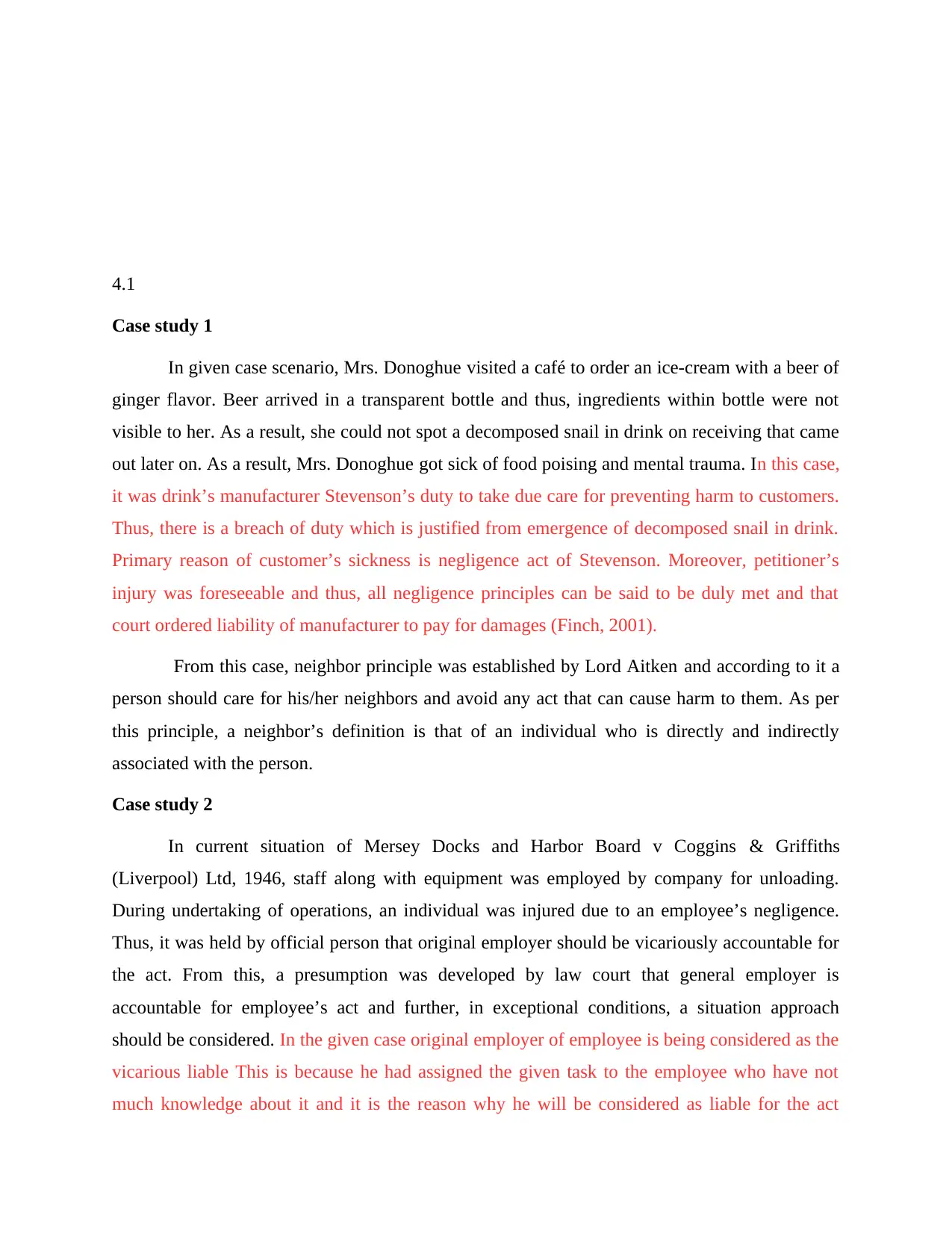
4.1
Case study 1
In given case scenario, Mrs. Donoghue visited a café to order an ice-cream with a beer of
ginger flavor. Beer arrived in a transparent bottle and thus, ingredients within bottle were not
visible to her. As a result, she could not spot a decomposed snail in drink on receiving that came
out later on. As a result, Mrs. Donoghue got sick of food poising and mental trauma. In this case,
it was drink’s manufacturer Stevenson’s duty to take due care for preventing harm to customers.
Thus, there is a breach of duty which is justified from emergence of decomposed snail in drink.
Primary reason of customer’s sickness is negligence act of Stevenson. Moreover, petitioner’s
injury was foreseeable and thus, all negligence principles can be said to be duly met and that
court ordered liability of manufacturer to pay for damages (Finch, 2001).
From this case, neighbor principle was established by Lord Aitken and according to it a
person should care for his/her neighbors and avoid any act that can cause harm to them. As per
this principle, a neighbor’s definition is that of an individual who is directly and indirectly
associated with the person.
Case study 2
In current situation of Mersey Docks and Harbor Board v Coggins & Griffiths
(Liverpool) Ltd, 1946, staff along with equipment was employed by company for unloading.
During undertaking of operations, an individual was injured due to an employee’s negligence.
Thus, it was held by official person that original employer should be vicariously accountable for
the act. From this, a presumption was developed by law court that general employer is
accountable for employee’s act and further, in exceptional conditions, a situation approach
should be considered. In the given case original employer of employee is being considered as the
vicarious liable This is because he had assigned the given task to the employee who have not
much knowledge about it and it is the reason why he will be considered as liable for the act
Case study 1
In given case scenario, Mrs. Donoghue visited a café to order an ice-cream with a beer of
ginger flavor. Beer arrived in a transparent bottle and thus, ingredients within bottle were not
visible to her. As a result, she could not spot a decomposed snail in drink on receiving that came
out later on. As a result, Mrs. Donoghue got sick of food poising and mental trauma. In this case,
it was drink’s manufacturer Stevenson’s duty to take due care for preventing harm to customers.
Thus, there is a breach of duty which is justified from emergence of decomposed snail in drink.
Primary reason of customer’s sickness is negligence act of Stevenson. Moreover, petitioner’s
injury was foreseeable and thus, all negligence principles can be said to be duly met and that
court ordered liability of manufacturer to pay for damages (Finch, 2001).
From this case, neighbor principle was established by Lord Aitken and according to it a
person should care for his/her neighbors and avoid any act that can cause harm to them. As per
this principle, a neighbor’s definition is that of an individual who is directly and indirectly
associated with the person.
Case study 2
In current situation of Mersey Docks and Harbor Board v Coggins & Griffiths
(Liverpool) Ltd, 1946, staff along with equipment was employed by company for unloading.
During undertaking of operations, an individual was injured due to an employee’s negligence.
Thus, it was held by official person that original employer should be vicariously accountable for
the act. From this, a presumption was developed by law court that general employer is
accountable for employee’s act and further, in exceptional conditions, a situation approach
should be considered. In the given case original employer of employee is being considered as the
vicarious liable This is because he had assigned the given task to the employee who have not
much knowledge about it and it is the reason why he will be considered as liable for the act
Paraphrase This Document
Need a fresh take? Get an instant paraphrase of this document with our AI Paraphraser
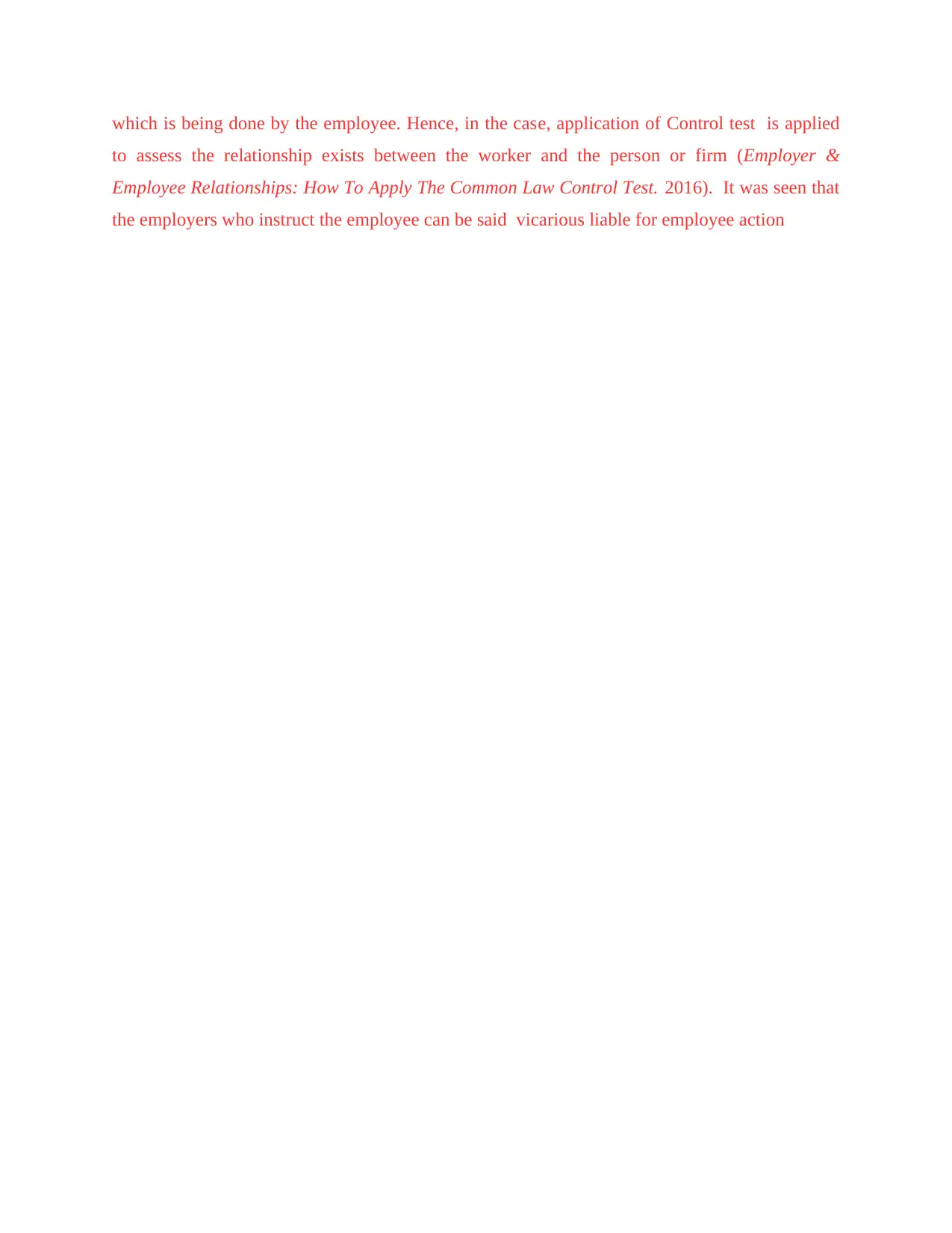
which is being done by the employee. Hence, in the case, application of Control test is applied
to assess the relationship exists between the worker and the person or firm (Employer &
Employee Relationships: How To Apply The Common Law Control Test. 2016). It was seen that
the employers who instruct the employee can be said vicarious liable for employee action
to assess the relationship exists between the worker and the person or firm (Employer &
Employee Relationships: How To Apply The Common Law Control Test. 2016). It was seen that
the employers who instruct the employee can be said vicarious liable for employee action
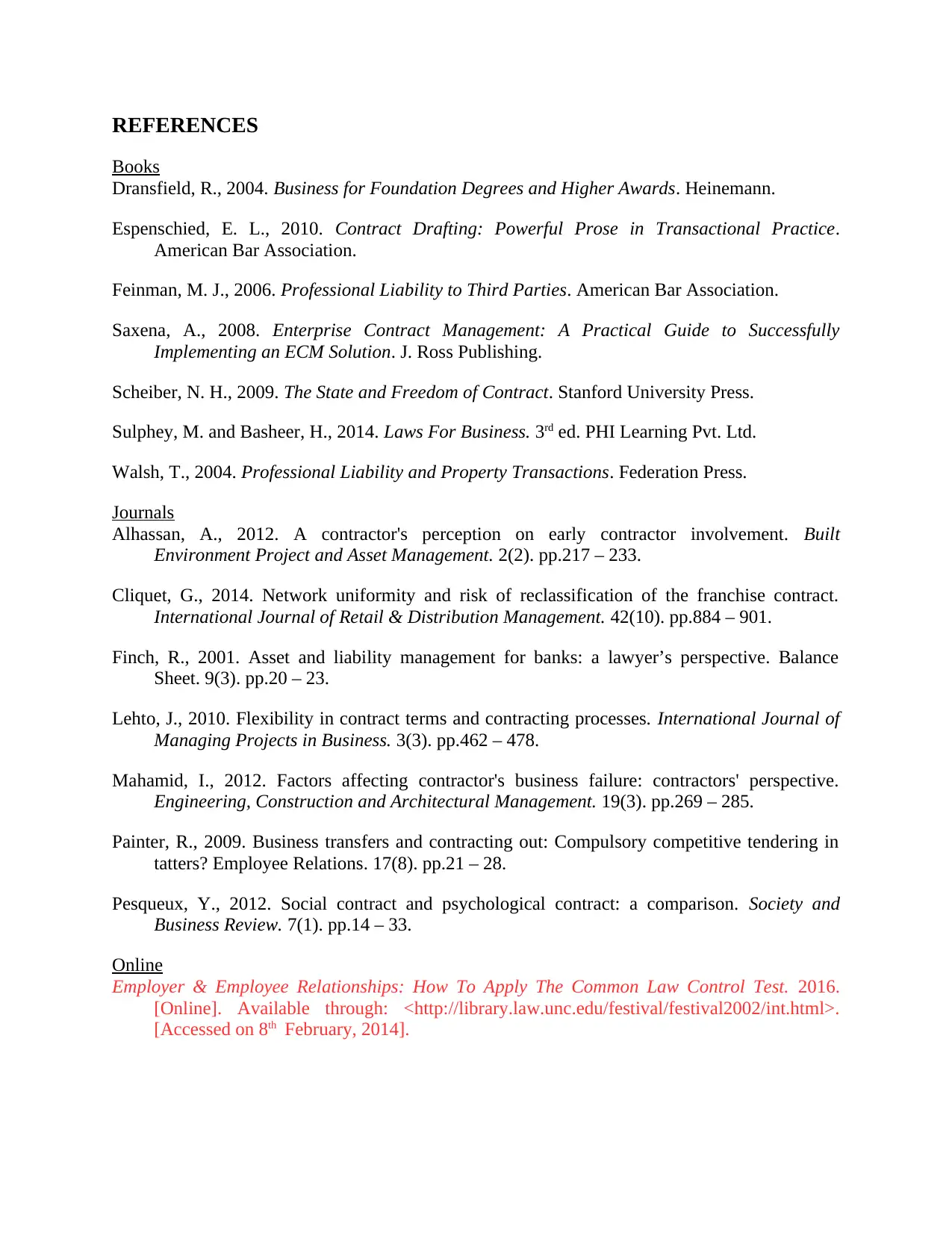
REFERENCES
Books
Dransfield, R., 2004. Business for Foundation Degrees and Higher Awards. Heinemann.
Espenschied, E. L., 2010. Contract Drafting: Powerful Prose in Transactional Practice.
American Bar Association.
Feinman, M. J., 2006. Professional Liability to Third Parties. American Bar Association.
Saxena, A., 2008. Enterprise Contract Management: A Practical Guide to Successfully
Implementing an ECM Solution. J. Ross Publishing.
Scheiber, N. H., 2009. The State and Freedom of Contract. Stanford University Press.
Sulphey, M. and Basheer, H., 2014. Laws For Business. 3rd ed. PHI Learning Pvt. Ltd.
Walsh, T., 2004. Professional Liability and Property Transactions. Federation Press.
Journals
Alhassan, A., 2012. A contractor's perception on early contractor involvement. Built
Environment Project and Asset Management. 2(2). pp.217 – 233.
Cliquet, G., 2014. Network uniformity and risk of reclassification of the franchise contract.
International Journal of Retail & Distribution Management. 42(10). pp.884 – 901.
Finch, R., 2001. Asset and liability management for banks: a lawyer’s perspective. Balance
Sheet. 9(3). pp.20 – 23.
Lehto, J., 2010. Flexibility in contract terms and contracting processes. International Journal of
Managing Projects in Business. 3(3). pp.462 – 478.
Mahamid, I., 2012. Factors affecting contractor's business failure: contractors' perspective.
Engineering, Construction and Architectural Management. 19(3). pp.269 – 285.
Painter, R., 2009. Business transfers and contracting out: Compulsory competitive tendering in
tatters? Employee Relations. 17(8). pp.21 – 28.
Pesqueux, Y., 2012. Social contract and psychological contract: a comparison. Society and
Business Review. 7(1). pp.14 – 33.
Online
Employer & Employee Relationships: How To Apply The Common Law Control Test. 2016.
[Online]. Available through: <http://library.law.unc.edu/festival/festival2002/int.html>.
[Accessed on 8th February, 2014].
Books
Dransfield, R., 2004. Business for Foundation Degrees and Higher Awards. Heinemann.
Espenschied, E. L., 2010. Contract Drafting: Powerful Prose in Transactional Practice.
American Bar Association.
Feinman, M. J., 2006. Professional Liability to Third Parties. American Bar Association.
Saxena, A., 2008. Enterprise Contract Management: A Practical Guide to Successfully
Implementing an ECM Solution. J. Ross Publishing.
Scheiber, N. H., 2009. The State and Freedom of Contract. Stanford University Press.
Sulphey, M. and Basheer, H., 2014. Laws For Business. 3rd ed. PHI Learning Pvt. Ltd.
Walsh, T., 2004. Professional Liability and Property Transactions. Federation Press.
Journals
Alhassan, A., 2012. A contractor's perception on early contractor involvement. Built
Environment Project and Asset Management. 2(2). pp.217 – 233.
Cliquet, G., 2014. Network uniformity and risk of reclassification of the franchise contract.
International Journal of Retail & Distribution Management. 42(10). pp.884 – 901.
Finch, R., 2001. Asset and liability management for banks: a lawyer’s perspective. Balance
Sheet. 9(3). pp.20 – 23.
Lehto, J., 2010. Flexibility in contract terms and contracting processes. International Journal of
Managing Projects in Business. 3(3). pp.462 – 478.
Mahamid, I., 2012. Factors affecting contractor's business failure: contractors' perspective.
Engineering, Construction and Architectural Management. 19(3). pp.269 – 285.
Painter, R., 2009. Business transfers and contracting out: Compulsory competitive tendering in
tatters? Employee Relations. 17(8). pp.21 – 28.
Pesqueux, Y., 2012. Social contract and psychological contract: a comparison. Society and
Business Review. 7(1). pp.14 – 33.
Online
Employer & Employee Relationships: How To Apply The Common Law Control Test. 2016.
[Online]. Available through: <http://library.law.unc.edu/festival/festival2002/int.html>.
[Accessed on 8th February, 2014].
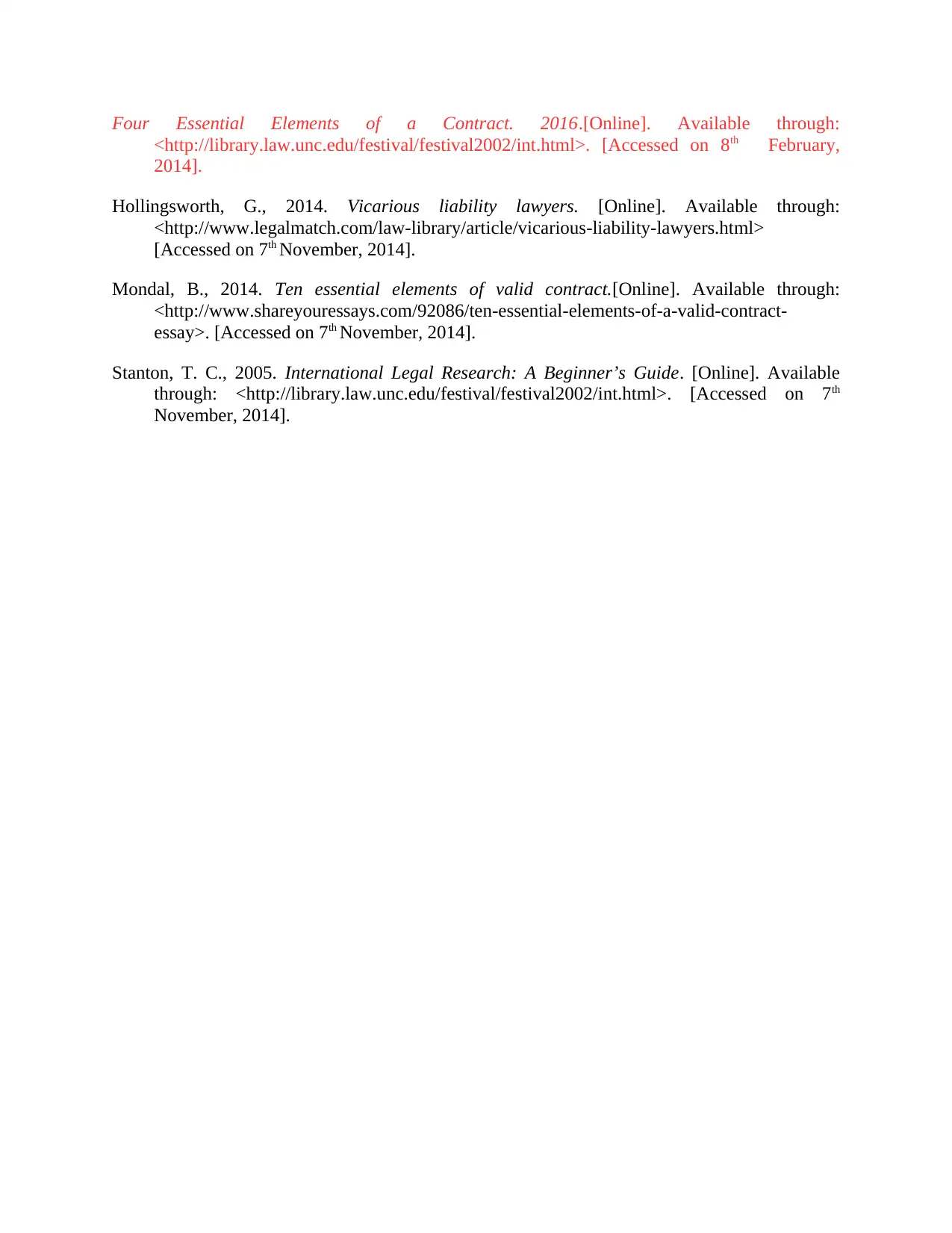
Four Essential Elements of a Contract. 2016.[Online]. Available through:
<http://library.law.unc.edu/festival/festival2002/int.html>. [Accessed on 8th February,
2014].
Hollingsworth, G., 2014. Vicarious liability lawyers. [Online]. Available through:
<http://www.legalmatch.com/law-library/article/vicarious-liability-lawyers.html>
[Accessed on 7th November, 2014].
Mondal, B., 2014. Ten essential elements of valid contract.[Online]. Available through:
<http://www.shareyouressays.com/92086/ten-essential-elements-of-a-valid-contract-
essay>. [Accessed on 7th November, 2014].
Stanton, T. C., 2005. International Legal Research: A Beginner’s Guide. [Online]. Available
through: <http://library.law.unc.edu/festival/festival2002/int.html>. [Accessed on 7th
November, 2014].
<http://library.law.unc.edu/festival/festival2002/int.html>. [Accessed on 8th February,
2014].
Hollingsworth, G., 2014. Vicarious liability lawyers. [Online]. Available through:
<http://www.legalmatch.com/law-library/article/vicarious-liability-lawyers.html>
[Accessed on 7th November, 2014].
Mondal, B., 2014. Ten essential elements of valid contract.[Online]. Available through:
<http://www.shareyouressays.com/92086/ten-essential-elements-of-a-valid-contract-
essay>. [Accessed on 7th November, 2014].
Stanton, T. C., 2005. International Legal Research: A Beginner’s Guide. [Online]. Available
through: <http://library.law.unc.edu/festival/festival2002/int.html>. [Accessed on 7th
November, 2014].
1 out of 10
Your All-in-One AI-Powered Toolkit for Academic Success.
+13062052269
info@desklib.com
Available 24*7 on WhatsApp / Email
![[object Object]](/_next/static/media/star-bottom.7253800d.svg)
Unlock your academic potential
© 2024 | Zucol Services PVT LTD | All rights reserved.




